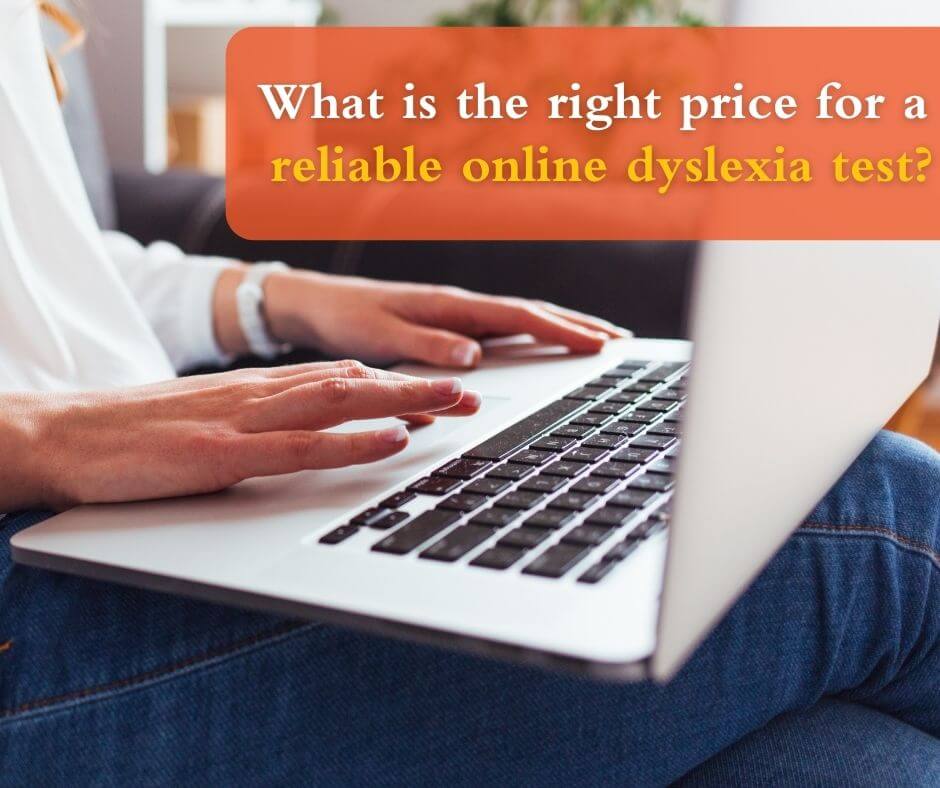Do you get worried about quality when a price seems too low? It’s natural to feel cautious.
We do get asked why our online QuickScreen dyslexia test is such good value, because it is so very different to a dyslexia assessment fee with an educational psychologist. However, we should not be comparing one against another.
Our test, at £34.50, provides a greatly needed service for adults that will simply never be able to afford a full face to face assessment at approximately £700.
But both are very valuable and make a difference to people’s lives.
It’s a sad reality that there are still 80% of people with dyslexia who leave full-time education without being identified, let alone being fully diagnosed. And after decades people still don’t have access to a test.
With this staggering statistic, it makes us all the more determined to offer the best quality service. Providing a test at a price that many people would not describe as expensive, but will be enormously valuable to their quality of life and assist with gaining workplace and learning support.
We are dedicated to making the process of identifying dyslexia fully accessible to everyone.
This need for online support has naturally been heightened with COVID-19, when face to face assessments have not been possible. An online solution is perhaps the only way forward for many people at this time.
“The Quickscreen dyslexia test provides a professional and detailed report. I’m so pleased that The Royal College of Radiologists accepted the QuickScreen certificate as evidence to warrant me 25% extra time during exams. I would highly recommend this test to any person with any doubts about the diagnosis of dyslexia. It helps you to take things further if needed at work and education.”
NHS Doctor
See more testimonials.
What do I get for £34.50 compared to £700?
We’re continuously improving and updating our QuickScreen dyslexia test.
There are 6 parts to the QuickScreen test: Verbal Skills, Visual Skills, Vocabulary, Memory, Sequencing and Processing. You can complete the 6 elements in any order and you don’t have to complete all sections in one go. You can typically complete all 6 elements in under 1 hour.
Upon completing the test, you will have a personal report that includes:
- A table of results – which is a two page summary of all the findings from the dyslexia test. It is an abridged version of a full dyslexia assessment showing:
- Scaled score, percentile rankings and descriptor bandings for Cognitive Skills, Underlying Skills and Verbal Processing
- Overall indicators of dyslexia as both a percentage and description (none, borderline, moderate or strong)
The QuickScreen test also provides:
- The ability to further recognise dyslexia in candidates who are often able to use strategies to mask their dyslexic traits, since they may still require special accommodation due to fluctuations in performance especially in moments of stress
- Fields for personal background information that, with refinements in the scoring system and our continuous research, mean that test results will show far fewer candidates in the borderline category, giving greater clarity to candidates taking the test
- Explanatory text about how to read the report after the test – including the colour coding for every result in terms of ‘needs attention’ within ‘normal limits’ and ‘above average’
- Recommendations for support tools for typing, increasing vocabulary and managing visual stress for improved reading speed and accuracy
- Options for learning support advisors issuing reports to candidates in a business or education environment, as well as the option to view the actual text produced by the user in the literacy test
- A Dyslexia Test Certificate for your workplace/educational provider upon request.
Other important credibility factors to consider:
- QuickScreen was developed by Dr. D. Walker, a dyslexia consultant from Pico Educational Systems, who has over 20 years of experience. In 1997, Pico launched the first adult computerised dyslexia test. Working on-line is now the norm, it is the pen and paper test that could be considered somewhat incomplete in its scope when testing relevant skills for current day requirements.
- QuickScan and QuickScreen are used by universities, colleges, armed forces, family services and other organisations.
- QuickScreen, has been independently verified. See our research data.
- Since November 2019, QuickScreen has been part of the Assured Scheme by the British Dyslexia Association (BDA).
“Pico Education have gone above and beyond to help me assess my adult dyslexia, in a clear and simple way, and have then provided incredible back up support me with the submission of the assessment to my professional examining body. They have been nothing but kind and helpful and offered quick and full answers to any queries I had. I would not hesitate to recommend them to anyone”
QuickScreen test user
We hope this blog is helpful in reassuring you of the quality of the QuickScreen test – despite its modest price tag.
If you have any questions about our test please get in touch with our friendly team.ÂÂ
- Call 020 8674 9571 between 9 am – 5 pm, Monday to Friday
- Email [email protected]
- Or use the the form on our contact page
“I have struggled all my life and kept my struggles a secret as I didn’t believe I could have dyslexia. After finally being offered the test – I came out as having dyslexia which was a real relief in one way as I can now finally get some help.”
D Jones

